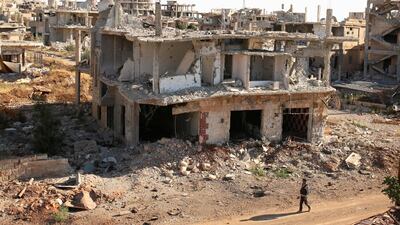The United States and Russia have reached a cease-fire agreement intended to halt fighting in southwest Syria, Secretary of State Rex Tillerson said.
The agreement, if carried out, could allow anti-government rebels there to focus on fighting Islamic State.
Mr Tillerson’s announcement came as Presidents Donald Trump and Vladimir Putin held their first face-to-face talks at the G20 summit in Hamburg, Germany.
The wide-ranging ceasefire would take effect Sunday at noon (Damascus time) in Southwest Syria.
This agreement is significant as it suggests a larger agreement between Washington and Moscow on Syrian influence zones and the decision to ignore the fate of Syrian President Bashar Assad is now seen as possible.
Mr Tillerson said the agreement, if it holds, may be a rolled out for other parts of the country. “This area in the south is our first show of success. We hope we can replicate that elsewhere,” he said.
Diplomatic sources in Washington told The National that Brett McGurk, the US Envoy for the Global Coalition to Counter ISIS, has been “instrumental in panning out the deal” and that “intricate details and areas of influence are discussed with the players involved.” It was reported last month that Mr McGurk and US Syria envoy Michael Ratney held secret talks with Russia in Jordan in May.
In a statement on Wednesday, Mr Tillerson announced: “The United States is prepared to explore the possibility of establishing with Russia joint mechanisms for ensuring stability, including no-fly zones, on the ground ceasefire observers, and coordinated delivery of humanitarian assistance” that “would lay a foundation for progress on the settlement of Syria's political future”.
Today Mr Tillerson added, “We have a very clear picture of who will provide the security forces, but we have a few more details to work out,” he said. Those discussions should be finalized within a week. “The talks are very active and ongoing.”
Syria’s civil war has seen forces loyal to Assad and Iranian allies pitted against rebel forces seeking to impose a brutal Islamic rule.
Randa Slim, director of The Middle East Institute's Track II Dialogues initiative, which looks at facilitating policy and problem solving in the region, said Mr Tillerson’s statement and the ceasefire announcement “define the negotiation framework for US-Russia coordination in Syria.” Ms Slim believes that Russia would look to establish no-fly zones, ceasefire observer missions, and coordinated delivery of humanitarian assistance. For the US, the priority will be to “ensure that areas liberated from ISIS are not taken illegally by the Assad regime… and to prevent any future regime use of Chemical Weapons.”
The approach towards the situation in Syria seems to be more straight forward from the Trump administration, opines Nicholas Heras, a Fellow at the Center for a New American Security (CNAS).
“The Trump team is much more candid and honest than the Obama administration about the need to have Russia bought into the framework that de-escalates the Syrian civil war” Mr. Heras said.
What would this plan would look like? Mr. Heras explained that “Syria is already partitioned into zones of control, and the American zone of control in eastern Syria is growing every day.”
Mr Heras added that he thought reinforcing this soft partition of zones and assigning control is implementable because Syria is not a cohesive state under one government.
The diplomatic sources in Washington said the American zone of influence would “stretch into the Jazeera region in Syria” which covers some of the border areas with Iraq, Raqqa, Tal Abyad and areas that are already controlled by Syrian Democratic Forces, supported by the US.
The Jordan side of the border according to the ceasefire will take place along a line of contact agreed upon between Syrian government forces and associated troops on one side and rebels on the other. It is not known who would control the border with Israel, but a key goal for Tel Aviv is to drive out Iranian proxies from the bordering area. Jordan’s King Abdullah made a private visit to Washington last week where he met US Secretaries of State and Defense Tillerson and James Mattis among others.
Ms. Slim emphasized that “This is the only plan on the table right now that the US could live with and around which there is an emerging international and regional consensus.”
The plan does not concretely address the fate of Assad whom the US called on to step down in August of 2011.
Mr Tillerson said: “We see no long-term role for the Assad family or the Assad regime,”, while a US state department official said “regarding Assad, the United States remains committed to the Geneva process and supports a credible political process that can resolve the question of Syria’s future.”
“Ultimately, this process, in our view, will lead to a resolution of Assad’s status, the Syrian people should determine their country’s political future through a political process” the US official stressed.
Jordan and Israel were also involved in the negotiations. The two countries are critical U.S. allies who have voiced concerns over the heightened militarization activity on their border with Syria.
Mr Heras believes Iran remains a wild card in this plan and whether it challenges the US zone of influence or remains present through proxies by the Syrian-Israeli border. “Assad and Iran will try to target the local Syrian partner forces that are waging the Coalition's counter-ISIS campaign” but “agreement between the Americans and Russians can restrain both” the expert said.
For Ms. Slim, however, Iran’s role “all depends on how Tehran sees this plan affecting Assad's long-term survival and what costs it will incur as far as its relationship with Moscow is concerned if it were to act as a spoiler.”
“If his survival is secured and the costs are high, it will not spoil it,” she added.


